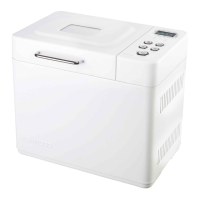31
General hints and tips
e results of your bread making are dependent on a number of different factors, such as the quality of
ingredients, careful measuring, temperature and humidity.
To help ensure successful results, there are a few hints and tips worth noting.
e bread machine is not a sealed unit and will be affected by temperature. if it is a very hot day or the
machine is used in a hot kitchen, then the bread is likely to rise more, than if it is cold. e optimum
room temperature is between 20C/ 68F and 24C/ 75F.
• On very cold days let the water from the tap stand at room temperature for 30 minutes before use.
Likewise with ingredients from the fridge.
• Use all the ingredients at room temperature unless stated otherwise in the recipe e.g. for the rapid 1
hour cycle you will need to warm the liquid.
• Add ingredients to the bread pan in the order suggested in the recipe. Keep the yeast dry and
separate from any other liquids added to the pan, until mixing commences.
• Accurate measuring is probably the most crucial factor for a successful loaf. Most problems are due
to inaccurate measuring or omitting an ingredient. Follow either metric or imperial measurements;
they are not interchangeable. Use the measuring cup and spoon provided.
• Always use fresh ingredients, within their use by date. Perishable ingredients such as milk, cheese,
vegetables and fresh fruits may deteriorate, especially in warm conditions. ese should only be used
in breads, which are made immediately.
• Do not add too much fat as it forms a barrier between the yeast and flour, slowing down the action
of the yeast, which could result in a heavy compact loaf.
• Cut butter and other fats into small pieces before adding to the bread pan.
• Replace part of the water with fruit juices such as orange, apple, or pineapple when making fruit
flavoured breads.
• Vegetable cooking juices can be added as part of the liquid. Water from cooking potatoes contains
starch, which is an additional source of food for the yeast, and helps to produce a well-risen, softer,
longer lasting loaf.
• Vegetables such as grated carrot, courgette or cooked mashed potato can be added for flavour. You
will need to reduce the liquid content of the recipe as these foods contain water. Start with less water
and check the dough as it begins to mix and adjust if it is necessary.
• Do not exceed the quantities given in recipes as you may damage your bread machine.
• If the bread does not rise well try replacing the tap water with boiled or cooled water. If your tap
water is heavily chlorinated and fluorinated this may affect the bread rising. Hard water can also
have this effect.
• It is worth checking the dough after about 5 minutes continuous kneading. Keep a flexible rubber
spatula next to the machine, so you can scrape down the sides of the pan if some of the ingredients
stick to the corners. Do not place near the kneader, or impede its movement. Also check the dough
to see if it is the correct consistency. If the dough is crumbly or the machine seems to be labouring,
add a little extra water.
• Do not open the lid during the proving or baking cycle as this may cause the bread to collapse.

